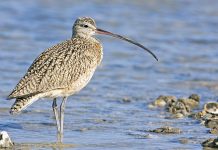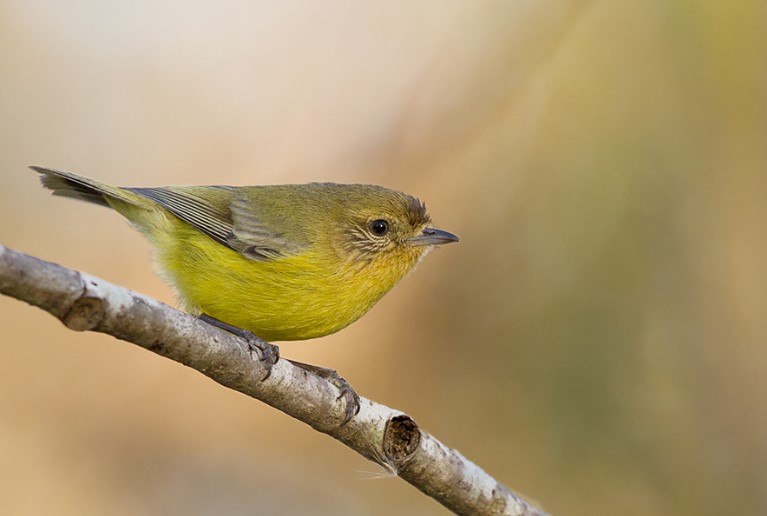The Madagascar Crested Ibis (Lophotibis cristata) is relatively common in the majority of the forests, from the Marovony Forest south through the Anosyenne Mountains to the Manantantely Forest. The highest elevation in the region for this species was recorded at the edge of the Varavara Forest, not far from Ankepotsy. This is approximately 1450–1500 meters.
Despite regular human persecution, the Madagascar Crested Ibis are still relatively common in the remaining tracts of littoral forest. This is particularly true at Manafiafy, Itapera, and Mandena. It was less common in humid forests. We generally saw single birds or pairs walking on the ground, often on trails, and occasionally in groups of up to seven individuals.
This species crosses open areas; for example, in late December, an adult was observed flying in the early morning between the Bezavona Forest and the littoral forest at Mandena, a distance of about 1 kilometer. The specimen label of a bird collected near Tolagnaro is common in dense second-growth forests. This species was absent from the petriky and spiny forest habitats.
It appears to be rare at the RP de Berenty; this species was never observed there or at Bealoka during over 2.5 years of intensive fieldwork in the mid-1980s. Local human pressure has been present for 400 years. People living near Manafiafy and Mandena have a variety of techniques to catch this species.

One type of trap is made from a series of approximately 1-meter-long sticks inserted about 10 cm into the ground to form a spiral funnel trap. The roof is closed off with lashed-together Ravenala leaves, or the sticks on opposite sides of the structure are angled to be attached. At the closed end of the funnel is a chamber.
This species cannot escape the chamber trap. These traps are often placed in areas that are frequented, such as narrow trails in the forest. Ground snares were also used to capture this species. We found no evidence that these traps were baited. Snares were also used to capture adults sitting on nests. This was done by slowly approaching the nest and placing a noose attached to the end of a long stick around the bird’s neck. We were told that nesting adults usually do not fly when approached.
In December, under a nest in the Manafiafy Strand Forest, we discovered the plucking feathers of an adult Madagascar Crested Ibis. Also, in this same locality, a resident brought us a live ibis that he had captured. Over the course of four months in late 1989, evidence was found near Manafiafy of at least five adult Lophotibis cristata being captured and eaten.
Nestlings and eggs are also removed from nests and consumed. The inaccessibility to humans of portions of the remaining forest and the difficulty of finding nests are presumably the main factors that allow the continued existence of this species in the area. All specimens examined from the area surrounding Tolagnaro refer to the nominated subspecies, including birds from Manafiafy, Mandena, and “Taolanaro, Tanosy”.
Birds occurring in the RP de Berenty area may well be L c. urschi, a subspecies confined to dry western and southern forests. Breeding—Near Manafiafy An adult was found incubating three eggs in a nest in a Pandanus about 6 m off the ground, 100 m from the seacoast, in the closed-canopy littoral forest. Nestlings are noted near Tolagnaro and Mandena.
In October, in the strand forest of Manafiafy, about twenty meters from the seacoast, two birds are observed displaying themselves to one another. The birds were flushed from the ground, flew up, and perched about one meter apart on a nearly horizontal branch about five meters off the ground. Throughout the next several minutes, they would bow toward one another, toss back their heads, return the bills to a horizontal position, and then touch the bills. After about 10 such displays, one bird flew off. The remaining bird moved around on the limb and uttered a faint, short wailing call.
This bird, perhaps disturbed by our presence, flew deeper into the forest. It resumed calling from another location, but this time it gave a series (up to 8 or 10 notes) of short, harsh notes on one pitch. In September and October, the bird calls during the night between dusk and dawn. On several occasions, it was observed perched in relatively tall dead trees, often at the forest edge or along a stream. It would chirp almost continuously for up to 30 minutes.
Diet—One individual was observed foraging in a small stream bed in a savanna area about 0.5 km from the edge of the Itapera Forest. It fed on water invertebrates. In the RNI d’Andohahela, at 400 meters, one bird is seen foraging by probing with its bill 5–10 cm into the bed of a forest stream. A Mandena nestling had some beetles remaining in its stomach. An adult from near Tolagnaro had “wireworms, centipedes, millipedes, and misc. “orthop.” in its stomach.
Soft Part Colors: The bill: lime green at the base merging to olive at the tip, gray with a black tip (immature); legs: pinkish red, pinkish yellow (immature); claws: dull black; iris: orangish red, brown (immature); orbital ring: pinkish red, dull yellowish pink (immature).
Local names: Akoala (Berenty), akoholahin’ala (Manafiafy, Marosohy, Marovony), akohon’ala (Manombo).
Other names: The bird is also known as the Madagascar ibis, white-winged ibis, and crested wood ibis.
Read More: Yellow-breasted boatbill







